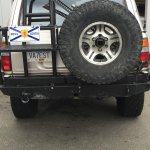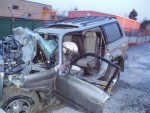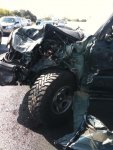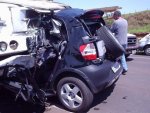jaymar
Member
How about one thread where anyone can look up significant + / - weight changes? Sure, you could use corner scales--but that doesn't give you individual component weights. And what if you're in the planning stage and have nothing to weigh? This can help with (for example) choosing a new suspension. Get the weight from the mfr, or weigh it yourself. Guesstimates don't count, and round up to the nearest pound. For example...
ALL WEIGHTS FOR 80 SERIES LAND CRUISER :
ARB Deluxe Bull Bar (non-winch) - 104 lbs / 47 kg
ARB Deluxe Bull Bar (winch) - 113 lbs / 51 kg
Odyssey PC2150 (Group 31) Battery - 78 lbs (x2 = 156 lbs)
I do not know what the oem stock battery was or weighed; would have to know that to calculate weight added to front end / front left. Anyone...?
Snomaster EX67D 66L Fridge/Freezer - 71 lbs / 32 kg
Goose Gear Solo Fridge Slide (XL) - 36 lbs
MaxTrax set (2 boards) with recovery straps and mounting pins - 16 lbs
Goose Gear Base Plate, 2-Drawer Box, 100% 2nd Row Delete - ~225 lbs*
*Okay, I said guesstimates don't count, but this one comes from GG. Has anyone weighed their 80 Series GG system components?
And what about deletions and swaps? What does the third row weigh, with hardware? The second row? Front row power, manual? What do Scheel-Manns and Planted brackets weigh in at? And so on...
Remember that "shipping weights" can be wildly inaccurate because of "dimensional" considerations. And then there are the packing materials (including pallets in some cases).
Feel to weigh in--and don't forget to specify your LC's year range...
ALL WEIGHTS FOR 80 SERIES LAND CRUISER :
ARB Deluxe Bull Bar (non-winch) - 104 lbs / 47 kg
ARB Deluxe Bull Bar (winch) - 113 lbs / 51 kg
Odyssey PC2150 (Group 31) Battery - 78 lbs (x2 = 156 lbs)
I do not know what the oem stock battery was or weighed; would have to know that to calculate weight added to front end / front left. Anyone...?
Snomaster EX67D 66L Fridge/Freezer - 71 lbs / 32 kg
Goose Gear Solo Fridge Slide (XL) - 36 lbs
MaxTrax set (2 boards) with recovery straps and mounting pins - 16 lbs
Goose Gear Base Plate, 2-Drawer Box, 100% 2nd Row Delete - ~225 lbs*
*Okay, I said guesstimates don't count, but this one comes from GG. Has anyone weighed their 80 Series GG system components?
And what about deletions and swaps? What does the third row weigh, with hardware? The second row? Front row power, manual? What do Scheel-Manns and Planted brackets weigh in at? And so on...
Remember that "shipping weights" can be wildly inaccurate because of "dimensional" considerations. And then there are the packing materials (including pallets in some cases).
Feel to weigh in--and don't forget to specify your LC's year range...
Last edited:





